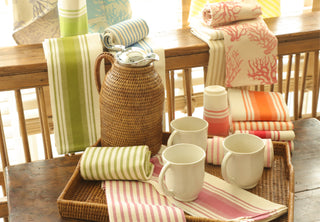
The dish towel’s more refined cousin has both an aesthetic and utilitarian history.
Considered a kitchen staple the world over, tea towels have gone from status symbol to everyday necessity.
Many people use the terms “tea towel” and “dish towel” interchangeably, but there are minor distinctions. Tea towels are crafted from linen or cotton and tend to be thinner than the average dish towel. The latter is typically made from terrycloth, adding more weight and absorbency.

Tea towels date back to 18th century England where society ladies would embroider or embellish linen for use during tea service. Heads of well-to-do households discovered linen wouldn’t scratch delicate china or crystal, making it an ideal base for a towel and—in many cases—a canvas for decorative needlework.
In later years, tea towels became less of a status symbol and more of a household essential. But they never lost their decorative flair with many manufacturers incorporating various colors and patterns. Tea towels remained popular even during the Great Depression—linen wasn’t readily available, so resourceful households started making towels out of cotton flour sacks.

Today’s tea towels range from plain to colorful to textured and can be used for much more than drying dishes. Here are a few creative functions for your tea towels:
Gift Wrap. Presentation is everything, so consider a tea towel for gifting baked goods, cheeses and other pantry items.
Table Settings. Decorative tea towels may double as placemats or napkins, adding a pop of color or a unique pattern to your table scape.
Home Décor. Vintage fabrics or intricate designs may be too special to put to everyday use. In these cases, tea towels can become decorative art.


